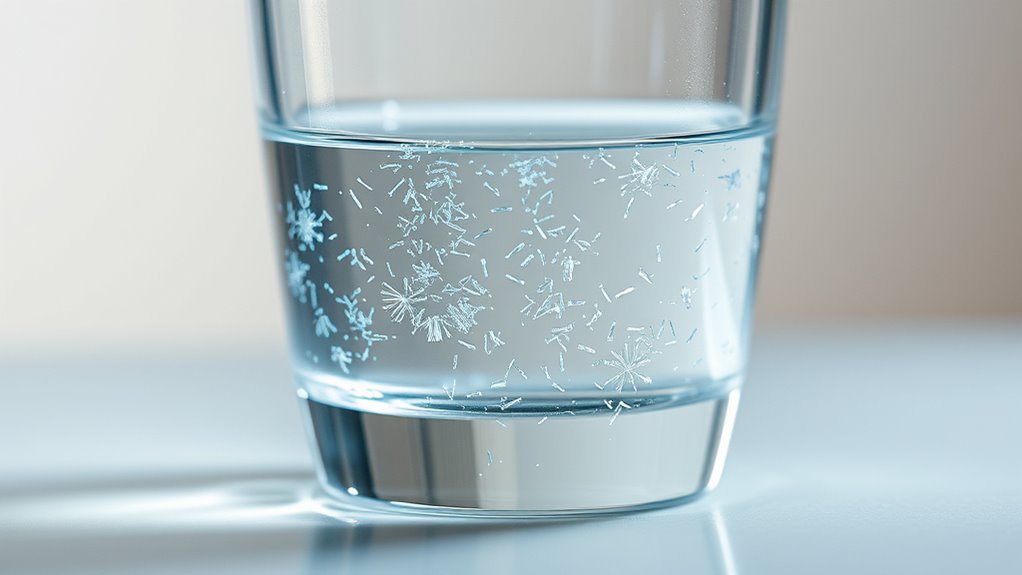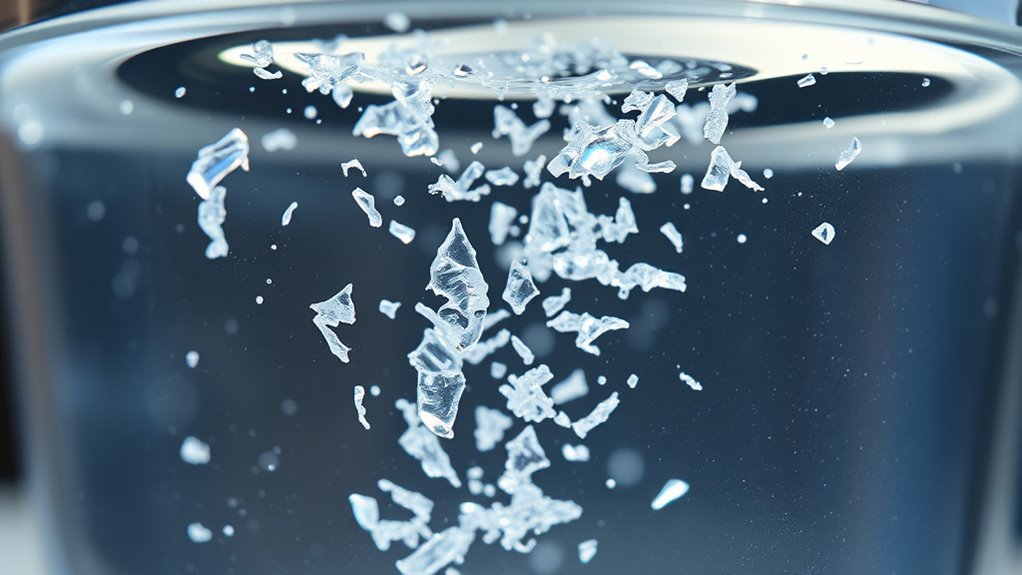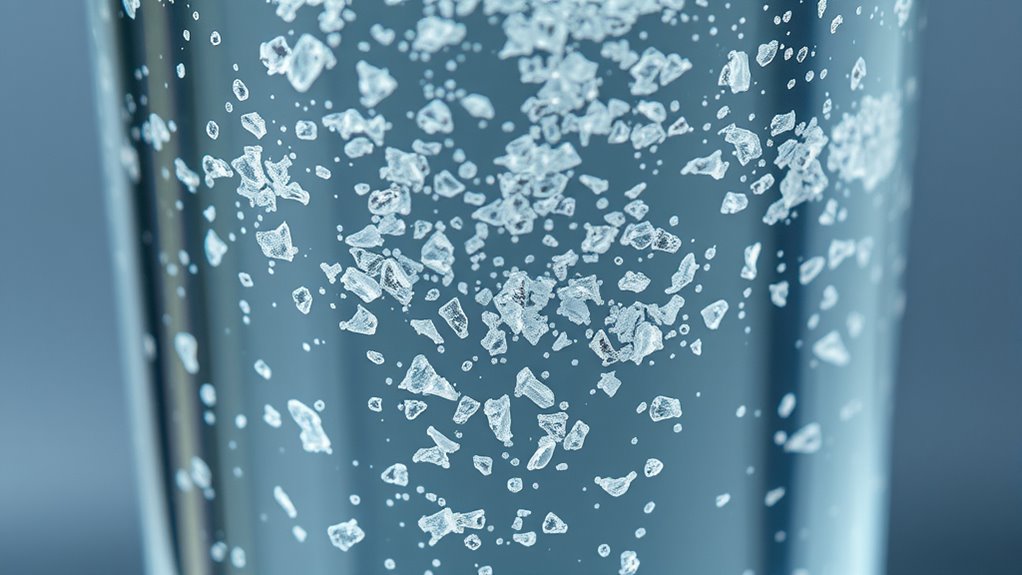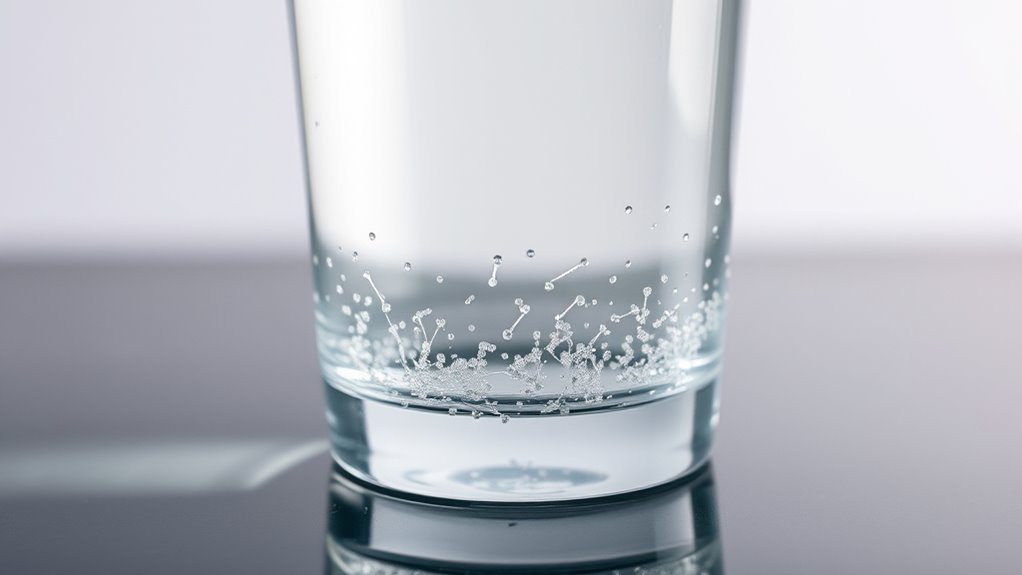Microplastics are tiny plastic particles smaller than five millimeters that often find their way into your tap water through plastic degradation and runoff. They can bypass filters and carry harmful chemicals, posing potential health risks like inflammation and cellular damage over time. To protect yourself, use specialized filtration systems and stay informed about water quality. Exploring further reveals how advanced detection methods and safety measures can help reduce your exposure to microplastic pollution.
Key Takeaways
- Microplastics are tiny plastic particles under five millimeters, originating from degraded larger plastics.
- They enter water sources through runoff, broken plastic waste, and can bypass standard filtration.
- Ingested microplastics may cause health issues like inflammation, cellular damage, and toxin exposure.
- Detecting microplastics requires advanced methods such as microscopy, FTIR, and Raman spectroscopy.
- Using specialized filtration systems and staying informed about water quality can reduce microplastic risks.
Understanding Microplastics: Tiny Particles, Big Concerns

Microplastics are tiny plastic particles less than five millimeters in size, and despite their smallness, they pose significant environmental and health concerns. Their origin often relates to plastic degradation, where larger plastics break down into smaller fragments over time due to sunlight, weather, and mechanical forces. Because of their small particle size, microplastics are easily ingested by marine life, animals, and even humans. The tiny particles can pass through water filtration systems, making them pervasive in tap water. Their small size increases the risk of bioaccumulation, as they can carry harmful chemicals into living organisms. Understanding how plastic degradation creates these minuscule particles helps you grasp the scale of the problem and why microplastics are considered a serious environmental threat. Utilize natural materials in everyday items to reduce plastic waste and microplastic formation.
How Microplastics Contaminate Our Water Supply

Because microplastics are so small and durable, they easily escape from plastic waste and enter our water supply. As plastics degrade over time, they break down into tiny particles that can bypass many water filtration systems. These microplastics can originate from discarded bottles, fishing gear, and synthetic textiles, which release particles into waterways through plastic degradation. Once in the environment, they are carried by rain and runoff into lakes, rivers, and groundwater sources. Standard water filtration methods often fail to remove these microscopic particles, allowing them to reach your tap. This contamination occurs because microplastics are too small for conventional filters to catch effectively, meaning they persist in water sources and make their way into your drinking water. Additionally, the increasing use of advanced filtration technologies can help reduce microplastic contamination in drinking water supplies.
The Potential Health Impacts of Microplastics

Although research is still ongoing, evidence suggests that ingesting microplastics may pose health risks. When you consume microplastics through tap water, these particles can accumulate in your body over time. Microplastic ingestion has been linked to inflammation, cellular damage, and potential interference with your immune system. While scientists are still studying the full extent, there’s concern about long term health risks, especially with continuous exposure. Tiny particles may carry harmful chemicals or toxins that could leach into your tissues. Over years, this buildup might contribute to health issues like gastrointestinal problems or even more serious conditions. It is also important to understand the influence of microplastics on overall health and immune response, as ongoing research continues to uncover potential impacts. It’s important to stay informed and minimize your microplastic exposure whenever possible, as the long-term effects are still being revealed.
Detecting Microplastics in Drinking Water

Detecting microplastics in drinking water requires sophisticated methods to accurately identify these tiny particles. Since microplastic sources vary—from consumer products to industrial runoff—you need precise detection techniques. Researchers often use advanced water filtration to concentrate microplastics from large water samples, making them easier to analyze. Techniques like microscopy, Fourier-transform infrared spectroscopy (FTIR), and Raman spectroscopy help identify the particles’ composition and size. These methods allow you to distinguish microplastics from other debris and ensure accurate measurement. Proper detection is essential for understanding contamination levels and evaluating potential health risks. While water filtration helps remove microplastics, detection methods focus on identifying what’s already present. This combination provides critical insights into microplastic pollution in your tap water. Incorporating data-driven strategies can further enhance the accuracy of contamination assessments.
Protecting Yourself and Your Water From Microplastic Pollution

To protect yourself and your water from microplastic pollution, taking simple, proactive steps can make a vital difference. Microplastic filtration systems are an effective way to remove tiny particles from your tap water, ensuring safer drinking water. Look for filters with fine pore sizes or specialized media designed to trap microplastics. Besides filtration, personal protective measures like using water filters or drinking bottled water in areas with high pollution levels can reduce your exposure. Regularly maintaining and replacing filters is essential for maximum performance. Additionally, stay informed about local water quality reports and advocate for improved water testing standards. Incorporating filtration technology can significantly enhance your water safety. By combining microplastic filtration with personal protective measures, you can considerably lower your risk and enjoy cleaner, safer water daily.
Frequently Asked Questions
Are Microplastics Visible to the Naked Eye in Tap Water?
You might wonder if microplastics are visible to the naked eye in tap water. Generally, microplastics are too tiny for visual detection, so water clarity doesn’t reveal them. Even if your water looks clear, it could still contain particles you can’t see. To accurately identify microplastics, specialized tests are necessary. Relying on visual detection isn’t enough, so consider water testing if you’re concerned about microplastics.
Which Countries Have the Highest Levels of Microplastic Contamination?
Imagine the Earth’s veins, where ocean currents carry the scars of industrial pollution. Countries like China, India, and Indonesia face the highest levels of microplastic contamination, as their rivers and coastal waters absorb and distribute these pollutants globally. You should be aware that these nations’ industrial activities and ocean currents combine to spread microplastics, making their environments and your tap water more vulnerable to contamination.
Can Boiling or Filtering Remove Microplastics From Water?
Boiling water doesn’t effectively remove microplastics because boiling limitations prevent tiny particles from being filtered out. Filtration effectiveness varies; certain high-quality filters, like those with activated carbon or specialized membranes, can trap microplastics, but standard filters often miss them. To reduce your microplastic intake, opt for advanced filtration systems designed specifically for microplastics, and don’t rely solely on boiling, as it won’t eliminate these tiny contaminants.
Are Children More at Risk From Microplastic Ingestion Than Adults?
You might think children are less vulnerable, but their developing bodies make them more susceptible to ingestion risks from microplastics. Child vulnerability increases because their smaller size means they absorb more contaminants relative to their weight. As a result, microplastic ingestion can pose greater health concerns for children than adults, and it is crucial to minimize their exposure by ensuring safe drinking water and reducing environmental contamination.
What Regulatory Standards Exist for Microplastic Levels in Drinking Water?
You might wonder about regulatory standards for microplastic levels in drinking water. Currently, there’s limited regulatory enforcement specifically targeting microplastics, as international guidelines are still developing. Agencies like the EPA and WHO haven’t set strict limits yet. However, some countries are beginning to research and monitor microplastic contamination, emphasizing the need for international collaboration to establish effective standards and protect public health.
Conclusion
To stay informed, to test, to filter—these steps empower you to protect your water and your health. By understanding microplastics, recognizing their presence, and taking action, you take control. You can reduce exposure, improve safety, and advocate for cleaner water. Because awareness leads to change, vigilance leads to prevention, and responsibility leads to a healthier future. Your choices matter—your water matters—because safeguarding your water safeguards your well-being.










